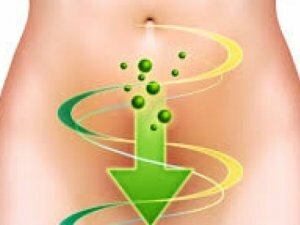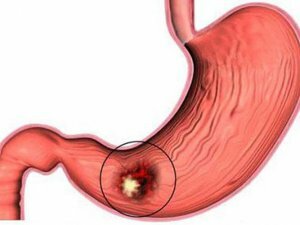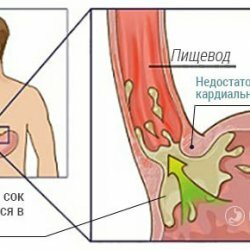Pain in the sternum in the middle
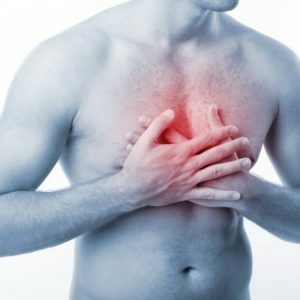 If somewhere it hurts, then the body is not all right.So quite rightly believe many people.You can not endure the pain, just as you can not ignore it.Especially when the pain is concentrated in the middle of the sternum.
If somewhere it hurts, then the body is not all right.So quite rightly believe many people.You can not endure the pain, just as you can not ignore it.Especially when the pain is concentrated in the middle of the sternum.
Causes of Pain
The sternum is an oblong bone located right in the middle of the human breast.The ribs are attached to the sternum and together they form a thorax.This bone structure protects the heart, large blood vessels, lungs, esophagus from mechanical damage from the outside.
Middle chest pains in the sternum can be caused by such pathological conditions:
- Heart and aortic diseases;
- Diseases of the esophagus;
- Diseases of the stomach;
- Diaphragm diseases;
- Diseases of the mediastinum;
- Diseases of the bone system;
- Neuropsychiatric diseases.
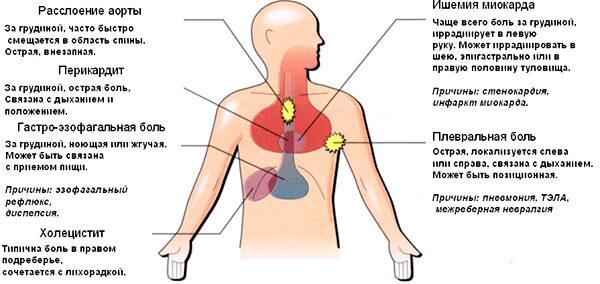
Heart Disease
If there is pain in the sternum in the middle, first of all, it is necessary to exclude probable heart problems, as the most dangerous cause. Indeed, in most cases, the pain in the sternum is caused by heart diseases, and more specifically, the .Coronary heart disease develops with insufficient supply of cardiac muscle with oxygen.In conditions of lack of oxygen, the myocardium suffers very much and gives a signal about it in the form of acute pain.Both angina and myocardial infarction are clinical forms of IHD.However, the nature of pain in these diseases is different.
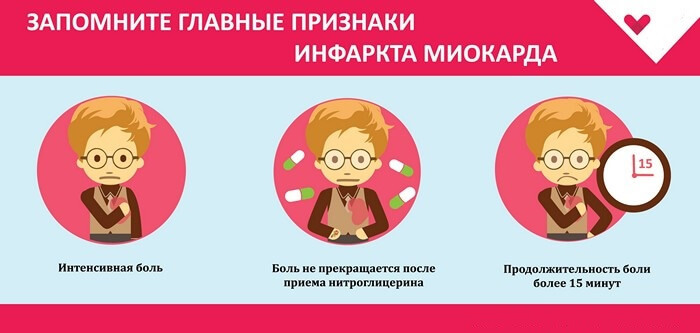
Stenocardia is typical of pressing pains behind the sternum.The patients themselves describe this pain, as if someone put a brick on the chest .The pain often radiates to the left arm, neck.Painful seizures last up to twenty minutes, the pain then overtakes, then releases the person.
Please note! A characteristic sign of angina is the elimination of pain after ingestion of nitroglycerin.
With severe shortage of oxygen, cardiac muscle dies off, so myocardial infarction develops.This disease is accompanied by a pressing, burning pain behind the sternum, but the pain is much more intense than with angina .The pain can also radiate into the left arm, neck, under the lower jaw, on the entire thorax and even the abdomen.Often the pain is accompanied by a feeling of pronounced fear of death, a cold sweat on the face. The pain is unbearable, after 15-20 minutes does not pass, and also is not stopped by nitroglycerin.
Pain in the sternum can also occur in inflammatory diseases of the heart - myocarditis and pericardial .This pathology occurs often after an infectious disease. In general, inflammatory heart diseases are characterized by such symptoms:
- Pain left in the chest, as well as the sternum;
- Elevated temperature;
- Weakness, malaise.
Diseases of the aorta
The occurrence of pain in the sternum can also be caused by aortic disease, in particular, its aneurysm. This is a local extension of the aorta site.Aneurysm of the thoracic aorta at the early stages is asymptomatic, but as the disease progresses, characteristic symptoms appear.
Signs of aneurysm of the thoracic aorta are:
- Prolonged pain in the sternum, region of the heart( painful attacks can last several days);
- Pain does not radiate;
- Does not resolve after eating nitroglycerin.
The danger of the ailment is that at any time the aneurysm can break down, leading to fatal bleeding. The rupture of aneurysm of the thoracic aorta is indicated by such symptoms as the appearance of severe pain behind the sternum, often radiating into the back, as well as the drop in blood pressure.
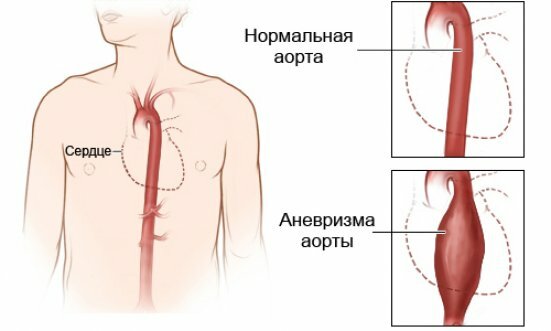
Diseases of the esophagus
Esophagus is located along the sternum.Therefore, it is not surprising that the diseases of this organ are often manifested by retrosternal pain. One of the most common diseases of the esophagus is achalasia of the cardia .This is an inadequate relaxation of the lower esophageal sphincter( cardia), which is why the passableness of the esophagus is disturbed.Thus, during swallowing the food lump gets stuck at the level of the spasmodic lower esophageal opening and can not get further into the stomach.
Symptoms of achalasia are:
-
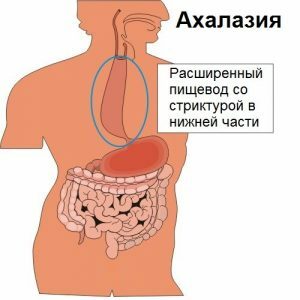 Feeling of difficulty in passing food while swallowing;
Feeling of difficulty in passing food while swallowing; - Feels of food stuck at the sternum;
- Pain in the sternum in the middle and slightly lower after eating, sometimes the pain is localized between the shoulder blades, radiating to the neck;
- Regurgitation of food eaten a few hours ago, which is especially amplified after the torso is tilted forward and after taking a horizontal position;
- Belching;
- Hiccough;
- Weight loss.
The appearance of pain in the sternum in the middle may also be associated with gastroesophageal reflux disease( synonymous with GERD). The disease is characterized by the development of inflammation of the mucosa of the esophagus due to the casting of gastric contents.The chest pains with GERD can irradiate into the inter-vascular region, the neck, the lower jaw, the left part of the chest.It is worth noting that esophageal pain is often mistakenly perceived as an attack of angina due to a similar clinical picture. However, the pain in the sternum with GERD has its own characteristics:
- The pain in the sternum occurs after eating;
- Strengthens after tilting the body forward, as well as in the horizontal position of the body;
- Decreased after use of antacids.
Important! In favor of GERD also show symptoms such as heartburn, belching sour, regurgitation of food.

Diaphragm Diseases
The diaphragm is a muscular-tendon plate separating the thoracic cavity from the abdominal.In the diaphragm there is a natural aperture - the esophagus, through which the esophagus leaves the thoracic cavity into the abdominal cavity.The development of a hernia of the esophageal aperture of the diaphragm is said, when through this opening the organs of the abdominal cavity protrude into the thoracic cavity.
The diaphragmatic hernia proceeds with pain in the sternum region in the middle and below, extending to the subsides of the .The pain can irradiate in the back, the interscapular region and even in the hypochondrium, than imitates shingles in pancreatitis. Features of retrosternal pain with diaphragmatic hernia:
- Pains often occur after eating, worse with flatulence, coughing, after lifting weights;
- Increases after tilting the body forward;
- Decreased after eructation, vomiting, deep inspiration or if a person takes an upright position;
- Pain can be characterized as moderate, blunt;
- Pains are associated with GERD symptoms.
Diseases of the stomach
It is known that gastric ulcer is manifested by pain in the epigastric region, often extending to the lower part of the sternum.Depending on the location of the ulcerative defect, the pain can also be irradiated to the left half of the thorax, the right hypochondrium, the back. The onset of pain is directly related to eating.Often, uncomfortable sensations appear after half an hour or hour after a meal.
Peptic ulcer is reduced after the use of drugs that reduce the gastric secretion of .In addition, at the height of a pain attack a person can vomit acidic contents, which brings relief.In favor of peptic ulcer is also evidence of eructation, nausea, constipation.It is also worth noting that in rare cases, pain in the sternum is manifested and acute pancreatitis, although for this ailment is more characteristic of the localization of pain in the upper abdomen.
Respiratory diseases
Diseases of the lungs, pleura flow with pain in the chest from the side of the lesion.But the pain directly in the sternum in the middle can manifest only tracheobronchitis. Usually this disease develops within the framework of ARVI.Therefore, at the beginning of a person's illness, weakness, fever, headache, nasal congestion, perspiration in the throat are disturbed.Discomfort sensations quickly descend, extending to the trachea and bronchi.
Pain in tracheobronchitis is located behind the sternum in its upper and middle third and is strengthened during the cough of .At the beginning of the disease, cough is dry, unproductive.When a person coughs, he feels an unpleasant sadness behind his breastbone.After a few days, the cough becomes wet, sputum loses easier.Gradually, the pain behind the sternum decreases, and overall well-being improves.
Mediastinal diseases
Mediastinum called anatomical space located in the chest cavity.Front space is limited to the sternum, behind the spine, and on the sides of the mediastinum there are lungs. In the mediastinum there are such organs as:
- Thymus;
- Trachea;
- The upper part of the esophagus;
- Heart;
- Primary bronchi;
- Large vessels and nerves.
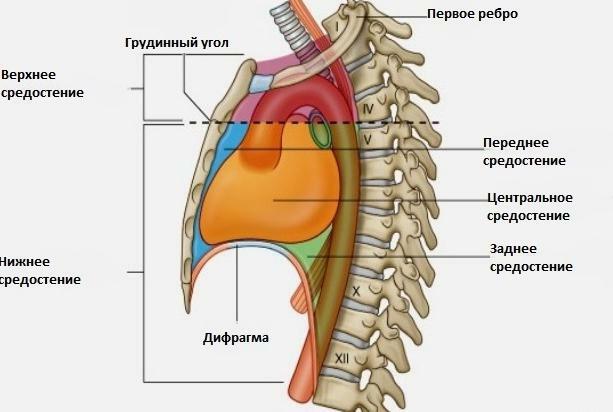
Inflammation of the mediastinal fiber is called mediastinitis.The disease develops when mediastinal infection occurs from neighboring inflamed organs( trachea, lungs, esophagus, heart, etc.), or when injuring the mediastinal organs. Acute mediastinitis develops suddenly and the first sign of it is the appearance of intense pain behind the sternum.Painful sensations are especially amplified when swallowing and tilting the head back . Also noted are the following signs:
- Fever;
- Chills;
- Heavy sweat;
- Shortness of breath;
- Cough;
- Suffocation;
- Heart rate disturbance;
- Puffiness of face and upper torso;
- Cyanosis of the skin.
Please note! Mediastinitis is a very serious condition and requires immediate medical attention.
Diseases of the bony system
It is logical to assume that the pain in the sternum can be caused directly by the diseases of this bone.But is worth noting that sternum diseases are very rare.Therefore, with the onset of chest pain, it is first and foremost necessary to think about the possible pathology of the heart or esophagus.
In traumatologic practice, doctors, though rare, still face a fracture of the sternum. This injury people get as a result of an accident when they hit the steering wheel with a chest, less often - with a direct stroke in the sternum or strong compression of the chest.In case of a fracture, the victim feels severe pain in the sternum, which is strengthened by breathing.In the fracture site, edema and subcutaneous hemorrhage are determined.When the fragments of the sternum are displaced, it is possible to damage adjacent organs, in particular the lungs, with the development of pneumo- or hemothorax.
The sternum, like any other human bone, can be affected by the malignant process of .Cancer of the sternum is a rare disease and yet it is worth mentioning about it.Cancer can arise in the sternum primarily or again - after the penetration of metastases into the bone.At the initial stages the illness does not manifest itself at all and the patient does not even suspect about his diagnosis.As the disease progresses, weakness, malaise, anorexia, subfebrile body temperature increase develop.Also at this stage, people begin to worry about chest pain.
Neuropsychiatric diseases
Sometimes a person seeks a doctor with a troubling pain in the sternum, but after research shows that the person is absolutely healthy.In this case, the pain is psychogenic, this condition is also called cardioneurosis. The patient himself describes his painful sensations, as if behind a sternum or a stone.There may also be a complaint about a rapid heartbeat, irregularities in the rhythm, "as if the heart wants to jump out."As a rule, all these phenomena arise after emotional experiences.A person very much worries about the chest pains, he suspects the presence of a dangerous disease.In general, for a person with cardioneurosis, anxiety, anxiety, multiple fears, insomnia and other manifestations of a hypochondriac character are characteristic.
Summing up all the above, it is necessary to emphasize the importance of timely detailed diagnosis of chest pain.It is very important to take into account, after which the pain is intensified or vice versa, where it radiates.In the situation with retrosternal pain, first of all it is necessary to exclude life-threatening diseases, such as myocardial infarction, aortic aneurysmia.
Grigorova Valeria, medical reviewer

